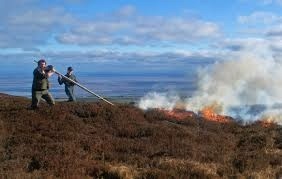Heather could be UK energy source according to new research coming out of Manchester.
Scientists at Durham and Manchester Universities believe harvesting energy from heather could cut greenhouse gas emissions and help the UK meet its bioenergy targets.
Heather grows naturally throughout the UK’s uplands, but land managers often burn it back to create better feeding grounds for grouse and livestock.
The study, published in the journal {i: Biomass and Bioenergy}, says this releases energy equivalent to burning 36,000 tonnes of coal every year.
If all the UK’s heather was harvested as a bioenergy crop, it could produce as much energy as 1.7 million tonnes of coal a year, achieving 15 per cent of the UK’s 2020 biomass target without taking any farmland out of production.
‘We have a large source of very efficient, low-carbon energy growing naturally on our uplands, but we’re releasing all its CO2 into the atmosphere without getting any energy from it,’ says Professor Fred Worrall, from Durham University, who led the study.
‘At the same time we’re burning coal to satisfy demand, and that’s a very dirty source of energy. Surely it would be possible to send the heather down the hill and stop burning the coal,’ he adds.
The UK is committed to the EU policy of producing 20 per cent of its energy from renewables by 2020. A third of this is expected to come from biomass.
Harvesting energy from heather could cut greenhouse gas emissions and help the UK meet its bioenergy targets, according to new research by experts at Durham and Manchester Universities
Heather grows naturally throughout the UK’s uplands, but land managers often burn it back to create better feeding grounds for grouse and livestock.
The study, published in the journal {i: Biomass and Bioenergy}, says this releases energy equivalent to burning 36,000 tonnes of coal every year.
If all the UK’s heather was harvested as a bioenergy crop, it could produce as much energy as 1.7 million tonnes of coal a year, achieving 15 per cent of the UK’s 2020 biomass target without taking any farmland out of production.
‘We have a large source of very efficient, low-carbon energy growing naturally on our uplands, but we’re releasing all its CO2 into the atmosphere without getting any energy from it,’ says Professor Fred Worrall, from Durham University, who led the study.
‘At the same time we’re burning coal to satisfy demand, and that’s a very dirty source of energy. Surely it would be possible to send the heather down the hill and stop burning the coal,’ he adds.
The UK is committed to the EU policy of producing 20 per cent of its energy from renewables by 2020. A third of this is expected to come from biomass.
Elephant grass and short-rotation coppice are by far the most common bioenergy crops in the UK, but both require productive farmland which could otherwise be used to grow food.
By contrast, heather grows on largely unproductive heaths and moors. To assess its potential as a bioenergy crop, scientists burned samples in the lab and measured the energy released.
Using Countryside Survey estimates of heather coverage in the UK, they scaled their calculations up to the regional level, and subtracted the likely energy costs of harvesting and transporting the crop to incinerators.
As well as meeting a substantial part of the UK’s bioenergy target, if it replaced its weight in coal, every hectare of heather could save 11 tonnes of carbon emissions a year.
But Worrall cautions that the industry could not take off everywhere. In parts of northwest Scotland, for example, heather grows too slowly, and the incinerators are too far away, to make it worthwhile.
Left to grow unabated, mature heather forms a blanket over the land. This makes poor grazing ground for sheep and grouse, and creates a large biological fuel store which can exacerbate the threat of wildfire.
For these reasons, land managers throughout the UK routinely burn off patches of heather. But the practice has attracted controversy in recent years.
There are concerns that it could be degrading moorlands, causing peat to erode more quickly into surrounding streams. This can harm water quality and raise the costs of treating it for human consumption.
If heather were to be harvested for energy, it would first need to be cut and baled. The environmental effects of this are not yet clear.
Worrall believes the main barriers to using heather as a bioenergy crop in the UK are now cultural, rather than technical.
‘From an engineering perspective it’s entirely possible,’ he says. ‘I think we have shown that there would be real benefits too.’
‘But there is a culture for burning among land managers, and my suspicion is that this would be difficult to overcome.’







